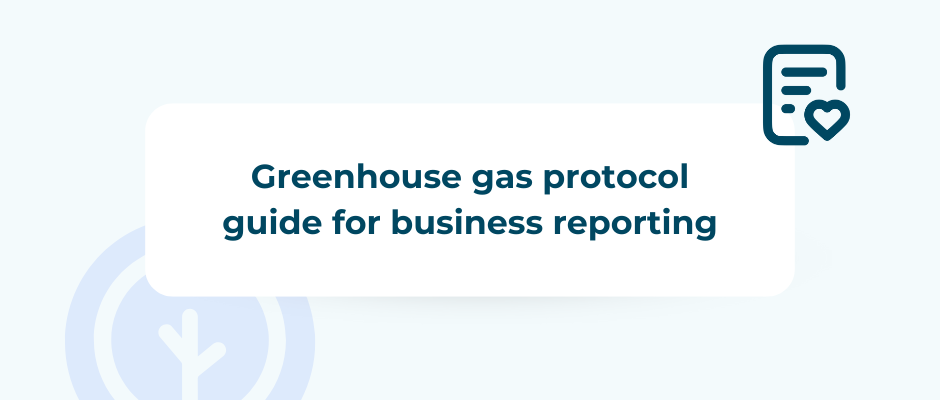Greenhouse Gas (GHG) Protocol: EU guide for business reporting
Reading time: 6 minutes
Reading time: 6 minutes

The Greenhouse Gas Protocol is the global gold standard for measuring and managing greenhouse gas emissions. For companies across the EU preparing carbon reports or shaping a climate strategy, it’s the bedrock of credible, consistent accounting.
In this article, you’ll:
By the end, you’ll have a clear, practical roadmap for applying the GHG Protocol to make informed decisions, unlock strategic insights, and stay ahead of evolving regulatory and stakeholder expectations.
The Greenhouse Gas Protocol (GHG Protocol) was launched in 1998 by the World Resources Institute (WRI) and the World Business Council for Sustainable Development (WBCSD). It offers a globally recognised framework for measuring and managing greenhouse gas emissions across entire organisations, value chains, and cities.
Today, over 90% of Fortune 500 companies that report emissions use the GHG Protocol. It provides the accounting backbone for initiatives like the Science Based Targets initiative (SBTi) and the Carbon Disclosure Project (CDP).
The Protocol is used by:
It’s a cornerstone of climate action planning for compliance and voluntary sustainability strategies.
Scope 1 covers all direct greenhouse gas emissions from sources owned or controlled by the company. Examples include:
Why it matters: These are most companies’ most measurable and controllable emissions.
Scope 2 includes indirect emissions from purchased electricity, heat, or steam consumption.
The GHG Protocol distinguishes two ways to report Scope 2 emissions:
Tip: EU companies aiming for net-zero often prioritise market-based reporting to show renewable energy usage.
Scope 3 includes all other indirect emissions in a company’s upstream and downstream value chain. There are 15 categories, such as:
Scope 3 can represent over 70% of a company’s total emissions. However, data collection is complex and relies on estimates or supplier disclosures.
Scope 3 often overlaps across different companies, especially in shared supply chains. The GHG Protocol encourages transparency and data quality improvements over time.
The GHG Protocol Corporate Standard provides the foundation for organisational-level carbon accounting. It sets the rules for defining boundaries, choosing methodologies, and calculating emissions across all scopes.
In 2015, the Protocol introduced Scope 2 Guidance, requiring companies to report market- and location-based emissions. This added clarity but also introduced complexity.
Upcoming updates are expected to refine rules for supplier-specific claims and certificates.
The GHG Protocol Scope 3 Standard outlines categorising and calculating value-chain emissions. Due to increased scrutiny, it’s undergoing major revisions, especially regarding:
A draft is expected in 2025, with final guidance by 2026.
The Corporate Sustainability Reporting Directive (CSRD) mandates detailed non-financial reporting for thousands of EU companies. It requires disclosure of Scope 1, 2, and 3 emissions—precisely what the GHG Protocol provides.
The Corporate Sustainability Due Diligence Directive (CSDDD) also requires businesses to identify and act on climate-related risks in their supply chains.
From 2024, large EU companies must report in accordance with the European Sustainability Reporting Standards (ESRS), which are harmonised with the GHG Protocol and SBTi frameworks.
Companies with over 250 employees, €40M turnover, or listed status must comply.
In response to growing demand and evolving policy landscapes, the GHG Protocol is updating:
Public consultations are running throughout 2024.
Expect:
Start by mapping your organisational and operational boundaries. Then, identify emission sources per scope. If primary data isn’t available, use default emission factors.
Carbon management software like Tapio can accelerate this process.
Don’t wait for perfect data. Focus on:
From there, define a reduction plan and a yearly update cycle.
For science-based targets or net-zero goals, GHG Protocol alignment is essential. Ensure:
The Greenhouse Gas Protocol is more than a reporting standard—it’s a powerful tool for structuring your decarbonisation journey. For EU-based companies, it offers the credibility, consistency, and compatibility needed to align with CSRD, CSDDD, and stakeholder expectations.
By understanding the three scopes, using available tools, and engaging with upcoming changes, your business can stay ahead of regulation, reduce emissions, and build trust.
The most critical step? Starting. You don’t need perfect data. But you do need a process. And the GHG Protocol provides just that.
Location-based reporting uses the average emissions from your country’s electricity grid. Market-based reporting uses your actual supplier or contract data (e.g. green energy). Both are required under the GHG Protocol.
By reporting Scope 1, 2, and 3 emissions using the Protocol’s structure, EU companies meet key ESRS climate disclosure requirements under CSRD.
Yes. It’s encouraged to start with estimates and improve them over time. Transparency about data quality is key.
Yes. The GHG Protocol offers Excel tools and guidance. Platforms like Tapio also support compliant, user-friendly data collection.
New standards and guidance are expected by 2026, with draft versions available in 2025.